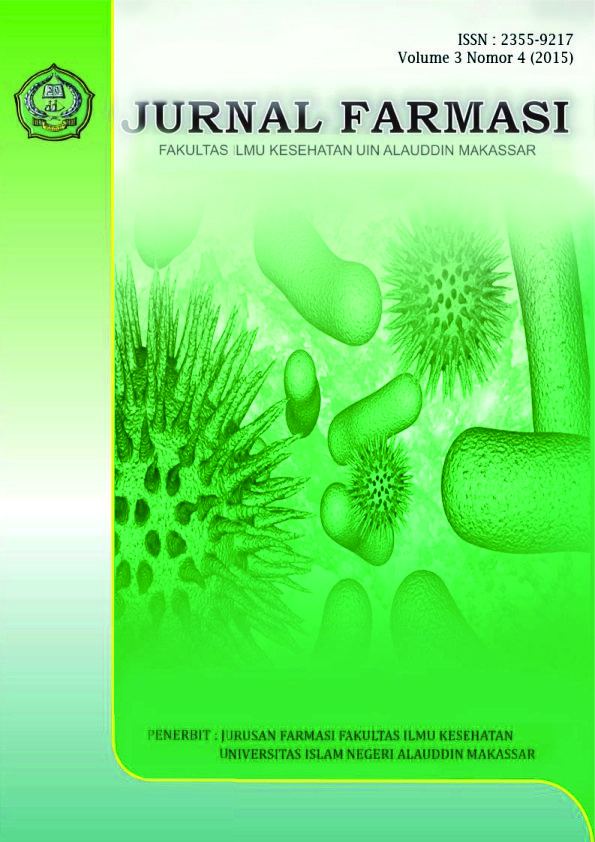DETERMINATION OF ETHANOL EXTRACT SUNSCREEN POTENTIAL OF RAMBUTAN RIND (Nephelium lappaceum L.)
Abstract
A sunscreen research to Determine the potential of rambutan rind (Nephelium lappaceum L.) ethanol extract has been conducted. This study aims to Determine the SPF value, percent transmission of erythema (% Te), and percent transmission of pigmentation (% Tp) of rambutan rind (Nephelium lappaceum L.) ethanol extract by using UV-VIS spectrophotometer.
Sunscreen potential determination of rambutan rind extract is done based on the SPF value measured at a wavelength of 290-400 nm, the calculation method% of% Te and Tp at a wavelength 292.5 to 372.5 nm at concentration 10, 20, 40, 80, and 160 ppm by using a UV-VIS spectrophotometer.
The results Showed that the SPF value of the extract at concentration of 10 ppm, 20 ppm, 40 ppm, 80 ppm, and 160 ppm respectively were 1.12; 1.23; 1.56; 2,37; and 5.32.The value of% Te at concentration of 10 ppm, 20 ppm, 40 ppm, 80 ppm, and 160 ppm respectively were 77.21; 62.87; 38.86; 16.18 and 3.10. The value of% Tp at concentration of 10 ppm, 20 ppm, 40 ppm, 80 ppm, and 160 ppm respectively were 88.01; 81.62; 68.41; 49.65 and 25.16. Obtained from the values, rambutan rind extract at concentration of 80 ppm has an SPF value of 2:37 the which means it has the potential for a minimum of sunscreen protection while at a concentration of 160 ppm, it has an SPF value of 5:32 the which means it has the potential of middle sunscreen protection. Rambutan rind extract at concentration of 80 ppm has a potential to protect against UV rays in suntan category with the value of percent tranmission erythema (% Te) by 16.18 and percent transmission of pigmentation (% Tp) by 49.65. At concentration of 160 ppm, it has a potential to protect against UV rays in extra protection category with the value of percent tranmission erythema (% Te) by 36.18 and percent transmission of pigmentation (% Tp) by 25.16 roomates includes in total blocks category.
References
Agustin, R., Yulida Oktadefitri, Henny Lucida. Sunscreen formulations of ethyl P-Metotoksinamat combination with catechins. Proceedings of the National Seminar on Recent Developments III Clinical Pharmacy and Science. Sumatra: Faculty of Pharmacy, University of Andalas. 2013.
Anief, Moh. Science dispensing medicine, Theory and Practice. Fourteenth mold. Yogyakarta: Gadjah Mada University Press, 2008.
Dalimartha, Setiawan, Indonesian Medicinal Plants Atlas Volume 3. Jakarta: Puspa Swara
Damogalad, Viondy. Formulation sunscreen Cream Skin Extract Pineapple (Ananas comosus L Merr) And Test In Vitro SPF value. Manado: Faculty of Mathematics and Natural UNSRAT, 2013.
Maulidia, Octa S. Test Effectiveness and Fotostabilitas 70% Ethanol Extract Cream Black Tea (Camellia sinensis L.) As Sunscreen In Vitro. Jakarta: Faculty of Medicine and Health Sciences UIN Syarif Hidayatullah 2010.
Rahmanto, Andi. Utilization of Jatropha Oil (jatropa circas L.) As a component of preparation in Product formulations Hand & Body Cream. Bogor: the Graduate School of IPB.
Rostamailis. Use of Basic Cosmetics Beauty And Dressed Healthy, Jakarta: PT Rineka Copyright 2005
Sudjadi. Methods of separation. Issue I. Yogyakarta: Pkanisius, 1988.
Susanti, M., Dachriyanus, Doni Permana Putra. Activities Protection UV rays Skin Fruit Garcinia mangostanaLinn SecaraIn Vitro. Journal of Pharmaceutical Indonesia Pharmacon.Surakarta: Faculty of Pharmacy, University of Muhammadiyah, 2012.
Tranggono, Retno I., Fatma Latifah. Handbook of Cosmetic Science, Jakarta: PT Gramedia main library, 2007

